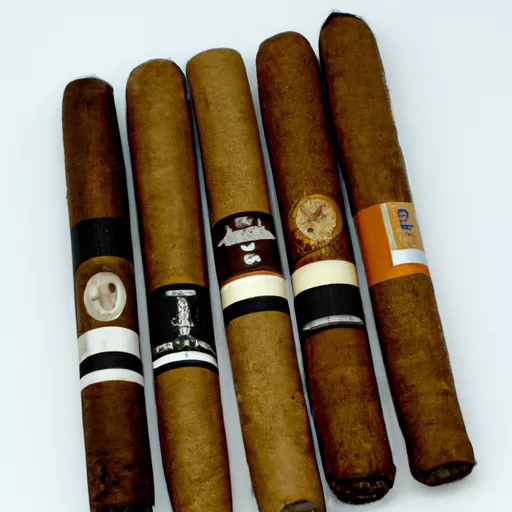
As a cigar lover, there is nothing quite like the experience of indulging in a cigar. The aroma, the taste, and the overall essence of relaxation that it brings is unmatched. But sometimes, you may not have the time or desire to commit to a full-sized cigar. That’s where little cigars come in.
Little cigars, also known as cigarillos or cheroots, are small cigars that provide the same flavors and sensations as a traditional cigar but in a more compact size. They are often misconstrued as cigarettes, but they are actually made with real tobacco leaves, unlike cigarettes which are made with processed tobacco.
I stumbled upon little cigars when I was short on time but still wanted to enjoy a good smoke. It was a game-changer, and since then, I have never looked back. In this article, I’ll share everything you need to know about these little gems.
History of Little Cigars
It’s hard to believe that something as popular as little cigars has a relatively unknown history. While the exact origin of little cigars is unknown, it is believed that they originated in Europe in the early 19th century. They were initially made for women as a substitute for cigarettes, which at the time, were considered socially unacceptable for women.
From Europe, the popularity of little cigars spread to the United States in the late 19th century, where they were marketed as a cheaper alternative to traditional cigars. They were also popular among soldiers during the Civil War, as they were easier to carry and smoke on the battlefield.
In the 20th century, little cigars gained popularity in the Caribbean and Latin America, where they became a staple in the cigar culture. Today, little cigars are still enjoyed worldwide, with a variety of flavors and sizes to choose from.
Composition and Types of Little Cigars
One of the biggest differences between little cigars and cigarettes is the composition. Little cigars are made with 100% tobacco leaves, while cigarettes contain a mixture of tobacco, additives, and paper or synthetic materials.
The composition of little cigars can vary, depending on the brand and type. Generally, they are made with a blend of tobacco leaves from different regions and may include fillers, binders, and wrappers made from different types of tobacco. The blend is what gives each little cigar its unique flavor and strength.
There are two main types of little cigars: natural and flavored. Natural little cigars are made with just tobacco leaves and are typically stronger in taste. Flavored little cigars, on the other hand, are infused with different flavors, such as vanilla, cherry, or chocolate, to add an extra layer of taste to the smoking experience.
How are Little Cigars Made?
The process of making little cigars is similar to that of traditional cigars, just on a smaller scale. The first step is harvesting the tobacco leaves from the tobacco plant. These leaves are then dried and fermented to develop their flavor and aroma.
Once the leaves are ready, they are sorted and aged, with different types of leaves being used for the filler, binder, and wrapper. The filler consists of a blend of different tobacco leaves, while the binder is used to hold the leaves together. The wrapper is the outermost layer, giving the cigar its appearance and flavor.
After the cigar is rolled, it is placed in a mold and pressed to give it its shape. The final step is adding the cap, which is a small piece of tobacco leaf that is placed at the head of the cigar to seal it.
Smoking Little Cigars
Before you light up a little cigar, it’s essential to understand the proper way to smoke it. First, you’ll need to cut the cigar, just like you would a traditional cigar. There are many types of cigar cutters available, but a guillotine or punch cutter will work best for little cigars.
Once the cigar is cut, you can then light it. Unlike cigarettes, which are typically lit with a match or lighter, little cigars can also be lit with a cedar spill, which is a thin strip of cedar wood used to light cigars. This method will prevent any impurities from being transferred to the cigar.
When it comes to actually smoking the little cigar, it’s best to take slow puffs, allowing the cigar’s flavors to develop. Because little cigars are smaller, they tend to burn faster, so you may need to relight the cigar more than once.
Benefits of Little Cigars
While traditional cigars are often seen as a luxury item, little cigars have their own set of benefits that make them a popular choice among cigar enthusiasts. For one, they are more affordable, making them accessible to a wider range of people.
They are also more convenient, as they are smaller and easier to carry around. A traditional cigar can take an hour or more to smoke, while a little cigar can be enjoyed in just 15-20 minutes, making them perfect for a quick break or while on the go.
Along with these benefits, little cigars also come in a wide variety of flavors, making it easier for smokers to find their preferred taste. They also have less nicotine and tar content compared to cigarettes, making them a healthier alternative.
Final Thoughts
In conclusion, little cigars may be small in size, but they pack a big punch when it comes to flavor and enjoyment. With a fascinating history, unique composition, and a variety of types and flavors, there is something for every cigar lover to enjoy.
Next time you’re short on time but still want to enjoy a good smoke, give little cigars a try. I guarantee you won’t be disappointed. But remember, just like with traditional cigars, moderation is key, so enjoy responsibly. Now, it’s time to sit back, relax, and savor the delicious taste of a little cigar.